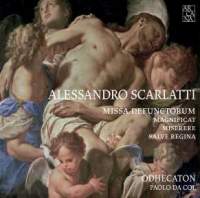Texte paru dans: / Appeared in: Arcana |
|
|
Outil de traduction ~ (Très approximatif) |
|
|
Reviewer: Bertil
van Boer With the exception of the Salve Regina, the other three pieces on this disc come from the later part of Alessandro Scarlatti’s life. The earliest is a double chorus Miserere from about 1708, a work that was probably written for the Sistine Chapel choir for Lent of that year. It was apparently not well received, and according to the excellent booklet notes by Luca Della Libera, it had been commissioned as a means of alleviating the “boredom” that the choir had with other pieces. Obviously, the expectations were high for a work on a level that reflected Scarlatti’s reputation. What was composed, however, is an austere work for a double chorus a cappella, where sections of simple polyphony or homophony alternate with bits of chant. These ritornellos are all rather repetitious in substance, but they do demonstrate a thorough knowledge of the Tridentine severe style. No soaring solos here, but rather the entire work is sedate and reflective, a perfect nod to the penitent feeling of this time of the church year. This appears in the middle of the disc immediately after the flowing and pensive Salve Regina, with its calm violin accompaniment and interwoven vocal lines. Although written over a decade earlier, it is a nice foil for the Miserere, and the voices move fluidly from suspension to suspension, in between which the violins have brief commentary that sounds like a nod to Giacomo Carissimi’s oratorio style, which Scarlatti knew intimately.
The main pieces, however, are a Magnificat and a Requiem Mass, both of which are austerely set only for voices and continuo. The Requiem (titled correctly Missa defunctorum) is a severe and powerful work, very much unlike Scarlatti the opera seria composer. The mood of lamentation is evident in the Introit, the solemnity of which even emerges in the modulation to a major key at the et lux perpetua. Of course, the Dies irae is a great stimulus for compositional creativity, and here the imitative counterpoint gives it a frenetic energy that does not need the extra instruments such as trumpets to get the point across. I notice on occasion among the imitative choral entrances some rather madrigal style syncopations, though the minor key keeps it on task in terms of its mood. Scarlatti is not afraid to use textural variations to create variety in the spare setting, and the glacial Lacrymosa has them emerge from a syrupy texture one by one in suspension, rendering the movement quite effective. The imitative Sanctus seems very much in the stile antico, with rising sets of suspensions that end in a homophonic statement before the Hosanna in excelsis returns to the Palestrina style. The Magnificat is likewise pensive and almost funereal in tone. Here Scarlatti could have written something joyous and uplifting, but instead prefers a more solemn church style. The opening is thus made more mysterious than praise-like, ending with a complex fugal conclusion. The Quia fecit has a rather nice series of solo lines that finally begin to show an affinity with the world of opera in the meandering coloratura. In the Fecit potentiam the two solo tenors weave an intricate counterpoint to the solo soprano above a steady continuo.
These are
not probably everyone’s cup of tea, in that the expectation is that
Scarlatti’s other sacred music is much more vibrant in manner. The austerity
of the sound is more introspective than effusive, and the older Tridentine
style peers through at virtually every turn, making these works a bit
anachronistic for the time. The ensemble Odhecaton gives a respectful
performance, with a richer lower set of voices that gives it depth. The
couple of instrumentalists used, a pair of violins and continuo, are
discreet and often choose to remain in the background. In the Salve Regina,
for instance, the two violins seem to disappear whenever they accompany the
voices, though they are very much present during the ritornellos. The sound
quality of the choir can sound a bit muffled at times, and the tempos can
occasionally plod, but the nature of the music I believe requires such a
cautious performance practice. If one expects the effusive and brilliant
Scarlatti, this will be a rather substantial change, but it does give an
interesting and worthwhile look at the depth of his more conventional
writing. | |
|
Support us financially by purchasing this disc from eiher one of these suppliers. Un achat via l'un ou l'autre des fournisseurs proposés contribue à défrayer les coûts d'exploitation de ce site. |
|
|
|
|
|
Cliquez l'un ou l'autre
bouton pour découvrir bien d'autres critiques de CD |
|




